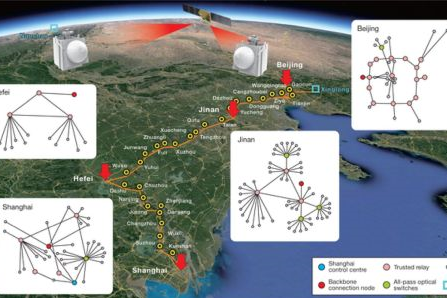Scientists, engineers and other specialists from several leading Chinese scientific institutions, led by scientists from the Chinese University of Science and Technology in Hefei, have completed the deployment of the world's first and largest integrated quantum communication network, which now combines about 700 fiber-based channels and several satellite channels. This network allows the implementation of quantum encryption key distribution technology over a maximum distance of 4,600 kilometers, and provides secure communication between major Chinese government, defense, financial and scientific organizations.
Unlike communications that use standard encryption methods, quantum communications are considered completely secure and not susceptible to hacking. Such quantum communication systems are ideal for the exchange of information between banks, government organizations and military enterprises. The basis of quantum communications is the technology of quantum key distribution (QKD), which allows you to transfer keys using the quantum state of particles, photons of light in most cases. At the same time, any attempt to "eavesdrop" or other type of interference immediately becomes known, the transmitted key becomes compromised and cannot be used to encrypt the transmitted information.
In 2016 China launched the Micius artificial satellite (QUESS), which implemented QKD technology between two ground stations located at a distance of 2,600 kilometers, and in 2017, a fiber-optic network with a length of more than 2,000 kilometers was put into operation, connecting Beijing and Shanghai. And these two components became the basis for the creation of a global Chinese quantum communication network.
Using additional fiber-optic segments and networks, specialized quantum relay stations and quantum satellite channels, the new network brought together more than 150 subscribers, which included electronic government systems, energy and power grid facilities, state and some private banks, industrial enterprises, including those of defense significance. All this is a demonstration that quantum communication technologies can already be used to create secure networks in practice. Moreover, quantum communication technologies are already ready for the integration of national quantum networks of different countries, only this will require work on the standardization of hardware and data protocols used.
The new implementation of the Chinese quantum network uses a variety of technological innovations, optimized hardware and software. For example, a higher clock speed and a new more efficient QKD protocol allows you to generate and transmit encryption keys at a speed of 47.8 kilobits per second. This speed can only cause a sad smile for those who are already used to mega - and gigabit data transfer speeds. However, given that the length of encryption keys does not usually exceed 2 kilobytes, a speed of 47 kilobits is quite enough to ensure the operation of the entire network with minimal delays, in addition, this speed is approximately 40 times higher than what was achieved before.
In the future, the Chinese plan to continue deploying the quantum network by adding new segments to it and increasing the number of subscribers connected to it. In addition, it is planned to connect the Chinese quantum network to networks or network segments in Austria, Italy, Russia and Canada. For this purpose, small but efficient quantum satellites and ground stations are being developed to ensure the efficient operation of QKD technology. In addition, quantum satellites for high Earth orbit are being developed, which will ensure the operation of QKD technology at record distances of tens of thousands of kilometers.

